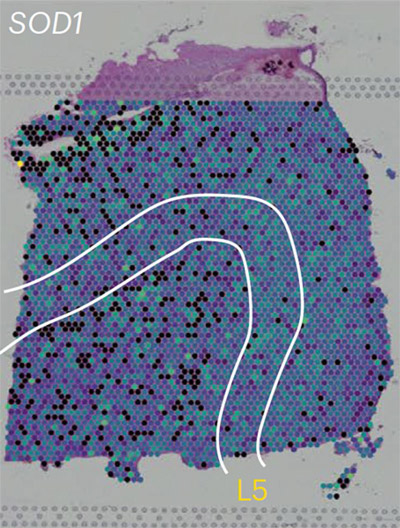NIH-funded study shines light on disease mechanisms, pointing to possible therapeutic targets
June 22, 2024 – In a small study, researchers have discovered how a set of genes could cause neurons to die in sporadic amyotrophic lateral sclerosis (ALS). The results, published in Nature Aging, provide insight into the root causes of ALS and may lead to new ways to halt disease progression. The study was funded by the National Institutes of Health (NIH).
ALS is a progressive neurological disorder that attacks motor neurons, nerve cells in the brain and spinal cord that control muscles, leading to muscle weakness, paralysis, and eventually death. Most cases of ALS are sporadic and occur in people without a family history or other clear  risk factors.
risk factors.
(Pictured) Genetic map of the ALS risk gene SOD1 in a sample of human brain tissue. Researchers discovered higher levels of gene expression (light green and blue) in a rare type of neuron found deep in the brain’s cortex. Eggan lab, Harvard University.
By analyzing the genetic profile of thousands of neurons from postmortem brain tissue from people who had ALS and from healthy donors, researchers identified higher levels of risk genes for ALS and frontotemporal dementia (FTD). The genes were especially prominent in Betz cells, a type of motor neuron, that express the marker THY1. In people with ALS, this was linked to disruptions in other neurons, hindering their ability to build, transport, and break down proteins. The genes—including SOD1, KIF5A, and CHCHD10—are among the most common associated with ALS/FTD.
Additional experiments showed that these changes may be connected to the toxic accumulation of the protein TDP-43, a defining feature of ALS and some cases of FTD. Therefore, higher levels of ALS risk genes in a distinct type of cell could trigger a harmful chain reaction that leads to widespread neuron loss.
Betz cell degeneration is a hallmark of ALS and is thought to occur early on when symptoms first appear. Understanding what makes these and other cells vulnerable to ALS could lead to new treatments that slow and even stop disease progression.
The team also explored how glial cells are affected by ALS. Glia are support cells that normally keep neurons healthy, but in ALS they can become dysfunctional and damage neurons, often accelerating their demise. Researchers analyzed genetic data from two kinds of glial cells and found genes related to cellular stress and inflammation. More research is needed to determine if glial cell dysfunction is a consequence or cause of neuron degeneration in ALS.
Together, the results enhance our understanding of why some neurons are more susceptible to ALS and identify potential novel therapeutic targets.
The study was supported by the National Institute of Neurological Disorders and Stroke (NINDS) (K08NS104270) and the National Institute on Aging (NIA) (P30AG062421). Single-cell sequencing and other resources were provided by the NIA-funded Massachusetts Alzheimer's Disease Research Center, one of 35 centers found across the United States.
Article: Limone, F., et al. “Single-nucleus sequencing reveals enriched expression of genetic risk factors in extratelencephalic neurons sensitive to degeneration in ALS.” Nature Aging. June 21, 2024. DOI: 10.1038/s43587-024-00640-0.
NINDS is the nation’s leading funder of research on the brain and nervous system. The mission of NINDS is to seek fundamental knowledge about the brain and nervous system and to use that knowledge to reduce the burden of neurological disease.
About the National Institute on Aging (NIA): NIA leads the U.S. federal government effort to conduct and support research on aging and the health and well-being of older people. Learn more about age-related cognitive change and neurodegenerative diseases via NIA’s Alzheimer's and related Dementias Education and Referral (ADEAR) Center website. Visit the main NIA website for information about a range of aging topics, in English and Spanish, and stay connected.
About the National Institutes of Health (NIH): NIH, the nation's medical research agency, includes 27 Institutes and Centers and is a component of the U.S. Department of Health and Human Services. NIH is the primary federal agency conducting and supporting basic, clinical, and translational medical research, and is investigating the causes, treatments, and cures for both common and rare diseases. For more information about NIH and its programs, visit www.nih.gov.
NIH…Turning Discovery Into Health®
Source: NIH








